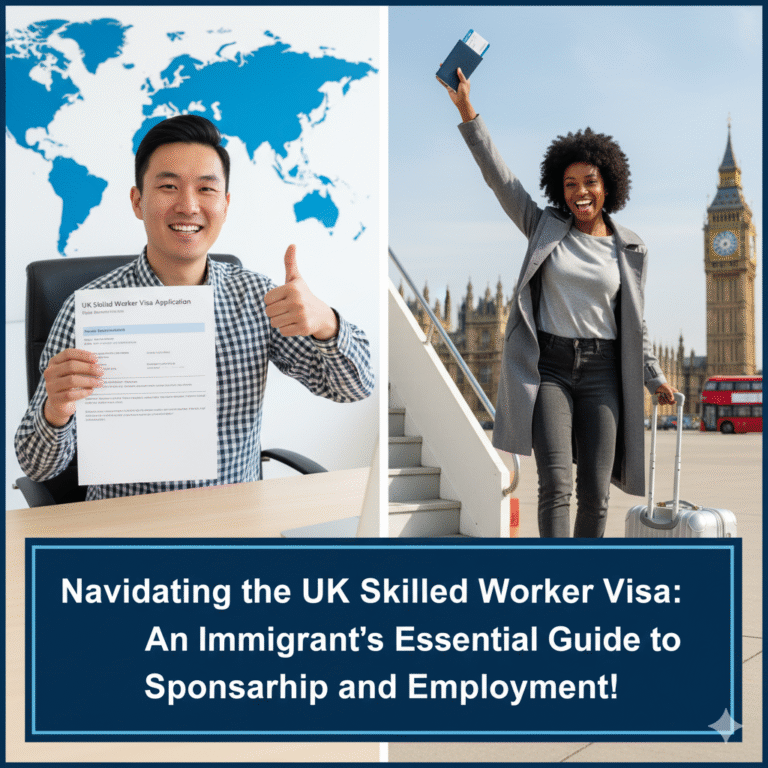The journey from receiving a UK job offer to starting your new position involves navigating a complex visa process that can feel overwhelming, particularly if this is your first experience with UK immigration. While the prospect of relocating to the United Kingdom for work is exciting, the administrative pathway requires careful attention to detail, strategic planning, and patience. This comprehensive guide walks you through every stage of the UK sponsored work visa process, transforming what might seem like bureaucratic chaos into a manageable, step-by-step journey.
Whether you’re a healthcare professional joining the NHS, a software developer moving to London’s tech sector, or an engineer relocating to Manchester, understanding the complete process from application to arrival empowers you to navigate each stage confidently, avoid common pitfalls, and ultimately begin your UK career with minimal stress and maximum preparation.
Stage One: Pre-Application Preparation (Weeks 1-2)
The work visa process actually begins before you submit any formal application. Thorough preparation during this crucial stage prevents delays, reduces stress, and ensures you have everything needed for a smooth application process.
Securing Your Certificate of Sponsorship
Your journey begins when your employer assigns you a Certificate of Sponsorship (CoS). This electronic record, containing a unique reference number, is your golden ticket—without it, you cannot proceed with your visa application. Your employer creates this through the Home Office’s Sponsorship Management System after finalizing your job offer and employment terms.
When you receive your CoS reference number, immediately verify the information it contains. While you cannot see all the detailed fields your employer entered, you should receive confirmation of key details including your name, passport number, date of birth, job title, occupation code, salary, and proposed start date. Check every detail meticulously against your passport and employment contract.
Even small errors can result in visa refusal. A single transposed digit in your passport number, a misspelled name, or an incorrect date of birth will cause problems. If you identify any errors, contact your employer’s HR or immigration team immediately. They can withdraw the incorrect CoS and issue a corrected one, but this must happen before you submit your visa application.
Your CoS is typically valid for three months from your proposed start date. Plan your application timeline to ensure you submit well within this validity period. If circumstances change and you cannot apply within the timeframe, your employer will need to issue a new CoS with an updated start date.
Gathering Essential Documents
While you’re verifying your CoS details, begin assembling the documents you’ll need for your application. Organization during this stage saves significant time and stress later.
Your current valid passport is the most critical document. It must have at least one blank page for your visa vignette and should be valid for your entire intended stay. If your passport expires soon, consider renewing it before applying for your visa. While you can travel on a passport that expires during your visa validity, having a current passport simplifies matters.
If you’ve previously held UK visas, gather those old passports or record of previous visa details. The application will ask about your immigration history, and having accurate information readily available streamlines the process.
Prepare proof of your English language ability. If you’re from a majority English-speaking country (like the United States, Canada, Australia, or New Zealand), your nationality typically satisfies this requirement. If not, you’ll need either a degree taught in English (requiring a certificate from UK ENIC confirming this) or results from an approved English language test at B1 level or above on the Common European Framework of Reference.
Financial evidence requirements depend on whether your sponsor certifies maintenance. Most established employers certify that they’ll support you during your first month in the UK, eliminating the need to show personal funds. If your sponsor doesn’t certify maintenance, you must prove you have at least £1,270 in your bank account, held for at least 28 consecutive days before applying.
Understanding Your Costs
Budget comprehensively for all visa-related expenses. The total cost can be substantial, particularly for families or longer visa durations.
The visa application fee varies based on your circumstances. As of late 2024, expect to pay approximately £719 to £1,500 depending on whether you’re applying from outside or inside the UK and the length of your visa. Healthcare and care workers benefit from reduced fees—approximately half the standard rate.
The Immigration Health Surcharge (IHS) is a significant expense. At £1,035 per year, a five-year visa requires £5,175 in IHS payments upfront. This charge grants you access to the National Health Service for the duration of your visa. Calculate the exact amount based on your visa length—even if you apply for five years, you’ll only pay IHS for the actual period granted.
Healthcare and care workers are completely exempt from the IHS—a substantial saving worth over £5,000 for a five-year visa. If you’re bringing dependents, they each pay separate visa fees and IHS, so family costs multiply quickly. A family of three applying for five-year visas might face total costs exceeding £15,000.
Additional expenses include biometric enrollment fees, document translation and certification costs, priority processing services if needed, and potential travel costs to visa application centers. Budget conservatively, adding a contingency for unexpected expenses.
Creating Your Timeline
Work backwards from your desired start date to create a realistic application timeline. Standard visa processing from outside the UK typically takes three weeks, though this can vary by location and time of year. From inside the UK, expect approximately eight weeks for standard processing.
Factor in time to gather documents, complete your online application, attend your biometric appointment, and allow for potential delays. Starting your application 8-12 weeks before your intended start date provides comfortable buffer time. If you’re in a rush, priority services can expedite processing, but these cost several hundred pounds extra.
Coordinate with your employer throughout this process. Keep them informed of your progress and any potential delays. Most employers experienced with sponsorship understand visa timelines and can accommodate reasonable adjustments to start dates if needed.
Stage Two: The Online Application (Week 3)
Once you’ve completed your preparation and have all necessary documents ready, you’re prepared to start the formal application process. The online application is detailed and requires careful attention.
Creating Your Account and Starting Your Application
Access the UK government’s visa application website and create an account. You’ll need an email address that you check regularly, as all communications about your application will come through this email.
Select the correct visa type—”Skilled Worker visa” in most cases, or “Health and Care Worker visa” if applicable. The system will ask screening questions to confirm your eligibility and direct you to the appropriate application form.
The online form is extensive, covering multiple sections including personal information, travel history, employment details, family members, and criminal record declarations. You can save your progress and return later, so you don’t need to complete everything in one sitting. However, once you submit and pay, you cannot make changes without withdrawing your application and starting over.
Completing the Application Form
Work through each section methodically, referring to your documents to ensure accuracy. The form will ask for:
Personal details: Full name exactly as it appears in your passport, date of birth, place of birth, nationality, and passport information. Double and triple-check these details—they must match your passport precisely.
Contact information: Current address, phone number, and email. Ensure this email is one you monitor regularly, as you’ll receive important updates here.
Travel history: Details of your international travel over the past ten years, including countries visited, dates, and purposes of travel. While you don’t need exact dates for every trip, provide as accurate information as possible. If you’re a frequent traveler, focus on longer trips and relocations rather than brief tourism.
Certificate of Sponsorship details: Enter your CoS reference number carefully. The system will pull information from your CoS, and you’ll confirm these details are correct. Verify that the information displayed matches what your employer told you.
Employment history: Details of your current and previous employment, including company names, positions, dates, and duties. This helps establish your work history and qualifications.
Educational qualifications: Information about your degrees, certifications, and professional qualifications. You may need to provide details about institutions, dates attended, and qualifications obtained.
Criminal record declarations: Honest answers to questions about criminal convictions, immigration violations, and other background check matters. The UK conducts thorough background checks, and dishonesty will result in refusal and potential ban from future applications.
Dependents: If you’re bringing family members, you’ll provide details about your partner and children. Each dependent completes a separate application linked to yours.
Paying Your Fees
After completing the form, you’ll proceed to payment. The system calculates your total fees based on your specific circumstances, including visa application fee, Immigration Health Surcharge, and any priority services you’ve selected.
Payment is typically by debit or credit card. Ensure you have sufficient funds or credit limit to cover the full amount—the transaction must complete in one payment. After successful payment, you’ll receive a confirmation email with your payment reference and next steps.
The Immigration Health Surcharge payment is notable because it’s calculated per year, rounded up to the nearest six months. If you apply for a five-year visa but are only granted four years and three months, you’ll receive a partial refund of overpaid IHS. Keep your payment confirmation for your records.
Scheduling Your Biometric Appointment
After payment, you must book an appointment to provide biometric information—fingerprints and a photograph. You’ll do this at a visa application center, which are located worldwide in most major cities.
Book your appointment as soon as possible after paying, as availability can be limited, especially during peak application periods. You typically have a window of several weeks to attend your biometric appointment, but earlier is generally better to keep your application moving forward.
When booking, select a convenient location and time. Bring your appointment confirmation, passport, and any documents you plan to submit with your application. Some applicants also bring copies of their application summary for reference.
Stage Three: Biometrics and Document Submission (Week 4)
Your biometric appointment is a straightforward but essential step in the visa process. Preparation ensures the appointment goes smoothly and your application progresses without unnecessary delays.
Attending Your Biometric Appointment
Arrive at the visa application center on time—preferably 10-15 minutes early. Bring your appointment confirmation email or letter, your passport, and any supporting documents.
Security at visa application centers is typically strict. You may not be permitted to bring electronic devices, large bags, food, or drinks into the facility. Check the specific center’s requirements in advance and plan accordingly. Many centers offer locker services for items you cannot bring inside.
The biometric enrollment process itself is quick, usually taking only 10-15 minutes once you’re called. A staff member will photograph you and scan your fingerprints. The photo taken becomes your visa photo, so dress appropriately—business casual is advisable. Remove glasses, hats, and other accessories as instructed.
If you have any issues with the biometric equipment—for example, if your fingerprints don’t scan well due to scars, skin conditions, or other factors—the staff will note this and work around it. Don’t be alarmed; they handle such situations regularly.
Submitting Supporting Documents
Most visa applications now use a fully digital document upload system. You’ll scan or photograph your supporting documents and upload them through the online portal.
Documents typically required include:
- Your current passport (information page showing your photo and details)
- Previous passports showing travel history
- Tuberculosis test certificate if you’re from a country where this is required
- English language test results or degree certificate (if not relying on nationality)
- Financial evidence (if your sponsor doesn’t certify maintenance)
- Any additional documents relevant to your specific circumstances
Ensure all documents are clear and legible. Color scans or high-quality photos work best. If documents aren’t in English, you must provide certified translations alongside the originals. The translator should include their credentials and certification with each translation.
Some applicants choose to bring physical documents to their biometric appointment as backup, even when using digital submission. While the digital upload is usually sufficient, having physical copies provides peace of mind if technical issues arise.
Document Translation and Certification
If any of your key documents aren’t in English or Welsh, they require certified translation. The translator must be qualified and include a signed confirmation that the translation is accurate and includes all information from the original document.
In many countries, professional translation services familiar with UK visa requirements offer this service. The translation should be on official letterhead, signed, dated, and include the translator’s credentials and contact information.
Some documents may require notarization or authentication beyond simple translation. Your local British embassy or consulate can provide guidance on whether specific documents require additional certification for UK immigration purposes.
Priority and Super Priority Services
If your start date is approaching quickly or you simply want faster processing, you can pay for expedited service. Priority Service aims to process your application within five working days, while Super Priority Service targets next-working-day decisions.
These services cost several hundred pounds on top of standard fees, but can be worthwhile if time is critical. However, they’re not available in all locations, and availability can be limited during peak periods. Additionally, these services expedite the decision but don’t guarantee approval—complex cases might still take longer.
Consider priority services if your employer needs you to start urgently, you have travel planned that could be affected by delays, or you want peace of mind from faster processing. However, standard processing times are reliable for most applicants, making priority services unnecessary in typical circumstances.
Stage Four: The Waiting Period (Weeks 5-7)
After submitting your biometrics and documents, you enter the waiting period while UK Visas and Immigration (UKVI) processes your application. This stage requires patience but also attention to communications and potential requests for additional information.
What Happens During Processing
Your application enters a queue for assessment by UK immigration officers. They review your documents, verify information against databases, conduct background checks, and assess whether you meet all requirements for the visa category.
The processing involves multiple checks including verification of your employer’s sponsor license status, confirmation that your Certificate of Sponsorship is valid and accurate, assessment of your financial position and English language ability, background and security checks through UK and international databases, and verification of any qualifications or certifications you’ve claimed.
Most applications are straightforward and proceed smoothly through these checks. However, complex situations—such as extensive travel history to certain countries, previous visa refusals or immigration issues, or complicated employment histories—may require additional scrutiny and therefore longer processing times.
Tracking Your Application
You can track your application status through the UKVI online system using your unique application number. However, the tracking information is often quite basic, typically showing only that your application is “in progress” until a decision is made.
Many applicants find the lack of detailed status updates frustrating. Unfortunately, there’s limited insight into where exactly your application sits in the queue or when you might expect a decision beyond the standard processing timeframe.
Avoid calling or emailing UKVI repeatedly for updates unless you’re well past the stated processing time or have genuine urgent circumstances. Processing times are generally reliable, and contacting them before the timeframe has elapsed rarely yields useful information and can actually slow processing slightly.
Responding to Requests for Additional Information
If UKVI needs additional information or clarification about any aspect of your application, they’ll contact you via email. Monitor your email regularly, including spam folders, to ensure you don’t miss any communications.
Requests for additional information should be taken seriously and responded to promptly. You’ll typically receive a deadline—often 7 to 10 days—to provide the requested materials. Missing this deadline can result in your application being refused based on insufficient information.
Common reasons for additional information requests include unclear financial documents, questions about employment history or qualifications, requests to clarify travel history or previous visa details, or requests for additional proof of relationship if applying with dependents.
If you receive such a request, gather the information quickly and submit it through the specified channel (usually email or online portal upload). Include a cover letter explaining how each document addresses the specific question asked. Clear, organized responses help officers process your clarification efficiently.
Managing Anxiety and Uncertainty
The waiting period can be stressful, particularly as your planned start date approaches. Develop strategies to manage anxiety during this time. Stay busy with preparation activities like researching your new city, learning about British culture, planning your relocation logistics, and maintaining regular communication with your employer about progress.
Remember that the vast majority of genuine, complete applications are approved. If you’ve been honest, provided accurate information, and meet all requirements, you should expect a positive outcome. Trust the process and focus on controllable aspects of your relocation.
Stage Five: Receiving Your Decision (Week 8)
When UKVI completes their assessment, you’ll receive a decision notification via email. This moment can be nerve-wracking, but understanding what to expect helps you respond appropriately regardless of the outcome.
Successful Applications
If your visa is approved, congratulations! Your decision email will explain next steps for collecting your passport with the visa vignette or, in some cases, receiving your Biometric Residence Permit.
For applicants from outside the UK, your passport will be returned with a visa vignette—a sticker that allows you to travel to the UK. This vignette is typically valid for 90 days and allows one entry. It’s not your actual visa but rather an entry clearance document.
Check all details on the vignette carefully: your name, passport number, validity dates, and visa type should all be correct. The vignette specifies when you can travel to the UK and how long you can stay. Note that the validity period shown on the vignette is not your full visa duration—it’s just the window for entering the UK.
Within 10 days of arriving in the UK, you must collect your Biometric Residence Permit (BRP) or, for newer applications, you may receive a digital immigration status instead. Your decision letter explains which applies to you and provides collection details if you’re receiving a physical BRP card.
The BRP is your actual visa document, showing your full visa validity period, any conditions or restrictions, and serving as proof of your right to work. Store it securely and carry it when traveling or starting employment.
If Your Application Is Refused
While most properly prepared applications succeed, refusals do occur. If your visa is refused, your decision letter explains the reasons in detail. Read this explanation carefully—it’s your roadmap for understanding what went wrong and how to address it.
Common refusal reasons include insufficient salary (not meeting the minimum threshold or going rate for your occupation), incorrect occupation code selected by your sponsor, financial evidence issues if your sponsor didn’t certify maintenance, errors or inconsistencies in the application form, failure to meet English language requirements, or concerns about the genuineness of your employment or your sponsor’s compliance.
You have several options after a refusal. You can request an administrative review if you believe the decision was based on a caseworker error—for example, if they didn’t properly consider evidence you submitted. This review costs £80 and must be requested within 14 days of receiving your decision. Administrative review is not an opportunity to submit new evidence or arguments; it only corrects clear errors in the original decision.
Alternatively, you can submit a fresh application addressing the refusal reasons. Your employer must issue a new Certificate of Sponsorship (you cannot reuse the original), and you’ll pay all application fees again. However, if you can clearly address the refusal reasons, a new application often succeeds.
Some refusals result from minor, easily correctable issues—perhaps a document was unclear, a salary figure was miscommunicated, or your employer selected a slightly incorrect occupation code. Your employer can adjust the problematic element and issue a new CoS for a fresh application.
More serious refusals, particularly those related to credibility concerns or sponsor compliance issues, may be harder to overcome. Consider consulting an immigration lawyer if your refusal involves complex issues or if you’re uncertain how to proceed.
Understanding Your Immigration Status
Once your visa is approved, understand exactly what rights and restrictions come with it. Skilled Worker visas allow you to work for your sponsor in the job described on your Certificate of Sponsorship, work up to 20 hours per week in certain other jobs (supplementary employment), do voluntary work, study, and travel in and out of the UK freely during your visa validity.
However, you cannot work for employers other than your sponsor as your primary employment without updating your visa, claim most public benefits (you have “no recourse to public funds”), or switch to a different visa category without meeting specific requirements.
Your visa period begins when you enter the UK or the start date on your CoS, whichever is later. This date is crucial for calculating when you’re eligible for visa extension or Indefinite Leave to Remain. Note it carefully and keep records of your entry date.
Stage Six: Pre-Departure Planning (Weeks 9-10)
With your visa approved, you can finalize travel plans and complete practical preparations for your move to the UK. Thorough planning during this stage ensures a smooth transition and helps you settle quickly once you arrive.
Booking Your Travel
Book flights that allow you to arrive comfortably before your start date. Allow several days between arrival and your first day of work to recover from travel, register with essential services, and handle unexpected issues.
If you have a physical visa vignette, you must travel within its validity period. Entry clearance vignettes are typically valid for 90 days but may be shorter in some cases. Check your vignette dates carefully and ensure your travel falls within this window.
Some migrants choose to arrive several weeks before starting work to apartment hunt, acclimate to the new environment, and manage practical tasks without the pressure of immediately beginning a new job. If financially feasible, this approach reduces stress significantly.
Temporary Accommodation Arrangements
Securing long-term housing from abroad is challenging without UK credit history, references, or the ability to view properties in person. Most international migrants book temporary accommodation for their initial period, then search for permanent housing after arriving.
Short-term rentals, serviced apartments, hotels, or corporate housing provide options for your first weeks or months. Budget for these costs when planning your relocation—temporary accommodation in major cities can be expensive, sometimes £50-150 per night depending on location and amenities.
Some employers offer relocation assistance, potentially including temporary accommodation or housing search support. Discuss what’s available with your HR team and take advantage of any benefits offered.
Financial Preparations
Opening a UK bank account is essential but typically requires proof of address, which you won’t have immediately. However, some banks offer specialized accounts for new arrivals with more flexible requirements. Research these options and gather any documents you might need, such as your visa, passport, employment contract, and proof of current address.
Understand how you’ll manage finances during your first month. Your first UK paycheck may not arrive until a month or more after starting work, depending on your employer’s pay cycle and start date. Ensure you have sufficient funds in accessible accounts to cover living expenses during this period.
Notify your current bank of your relocation to avoid account freezes due to unexpected international activity. Ask about international transaction fees and exchange rates if you’ll be transferring money between accounts in different countries.
Healthcare Registration
The Immigration Health Surcharge you paid grants access to the National Health Service, but you must register with a GP (general practitioner) after arrival. You cannot register in advance, but you can research GP surgeries in your destination area and understand the registration process.
Bring any ongoing prescriptions with sufficient medication to last until you can establish care with a UK doctor. Carry prescription details and your doctor’s contact information in case UK healthcare providers need to verify your medical history.
If you have specific healthcare needs—chronic conditions, regular medications, or upcoming medical appointments—research how the NHS handles these situations. The UK healthcare system differs significantly from many countries, particularly regarding specialists, prescriptions, and appointment procedures.
Professional Registration and Compliance
Some professions require registration with UK regulatory bodies before you can work. Healthcare professionals, teachers, social workers, lawyers, and certain other regulated professions must register with their respective professional bodies.
Your employer should inform you of any registration requirements during the hiring process, but verify independently. Process registration applications well in advance, as some registrations take weeks or months. Delays in professional registration can prevent you from starting work on time, even with a valid visa.
Gather documents you’ll need for employment verification in the UK. This typically includes original academic certificates and transcripts, professional certifications and licenses, previous employment references, and criminal background checks from countries where you’ve lived. Employers conduct right-to-work checks and may require these materials on or before your first day.
Saying Goodbye and Handling Current Obligations
Don’t neglect the personal and practical aspects of leaving your current location. Give proper notice at your current job (if employed), allowing time for knowledge transfer and maintaining professional relationships. Notify your landlord, terminate your lease appropriately, and handle any deposit refunds.
Cancel or transfer utilities, subscriptions, and services. Update your address with banks, insurance companies, government agencies, and other important institutions. File required paperwork with tax authorities regarding your departure if necessary for your circumstances.
Make time for meaningful farewells with friends and family. Moving abroad is emotionally significant, and proper closure helps you transition with fewer regrets. Document and share contact information so you can maintain important relationships across the distance.
Stage Seven: Arrival in the UK (Week 11)
Your arrival in the UK marks the culmination of months of planning and the beginning of your new life. Understanding entry procedures and immediate priorities helps you start strong.
Entry Procedures at UK Border
When you arrive at a UK airport or port of entry, proceed to the immigration control area. Look for the “All Other Passports” or “Non-EEA” line (signage varies by airport).
Present your passport with the visa vignette to the Border Force officer. They may ask questions about your employment, where you’re staying, and how long you plan to remain in the UK. Answer honestly and concisely—these questions are routine verification, not interrogation.
The officer will scan your passport and verify your visa details in their system. They may stamp your passport with your entry date (this stamp is important for calculating continuous residence for settlement purposes). The process usually takes just a few minutes unless they need to ask additional questions.
In rare cases, you might be directed to secondary inspection for additional verification. This isn’t necessarily concerning—it can happen for various routine reasons. Cooperate fully, answer questions honestly, and provide any requested documents. Most secondary inspections resolve quickly with no issues.
Collecting Your Biometric Residence Permit
If you’re receiving a physical BRP card, you must collect it within 10 days of arriving in the UK. Your decision letter specifies the collection point—either a post office branch or delivered to your UK address depending on your application choices.
To collect from a post office, bring your collection letter, passport, and any reference numbers provided. The post office staff will verify your identity and provide your BRP card. Check all details immediately: photo, name, date of birth, visa dates, and any conditions or restrictions.
Your BRP is your primary proof of immigration status in the UK. Store it securely and make copies for your records. You’ll need to show it when starting employment, accessing certain services, and traveling internationally (you must present both your passport and BRP when returning to the UK).
For digital immigration statuses (being rolled out for newer applications), you won’t receive a physical card. Instead, you’ll access your immigration status online through a government portal. Your decision letter explains how to access and share your digital status with employers, landlords, and others who need to verify your right to work or rent.
Immediate Administrative Tasks
Within your first few days, tackle essential administrative tasks. Register with a GP by contacting local surgeries and requesting registration forms. You’ll need your passport, BRP or proof of immigration status, and proof of address (your temporary accommodation booking may suffice initially).
Apply for your National Insurance number by contacting the Department for Work and Pensions. You can work before receiving your NI number, but you need it for your employer to process your taxes and National Insurance contributions correctly. The application is typically by phone, and you’ll receive your number by post within several weeks.
Open a UK bank account as soon as possible. Major banks like HSBC, Barclays, and Lloyds offer current accounts, though requirements vary. Some banks have dedicated services for new UK residents with more flexible documentation requirements. Having a UK bank account simplifies receiving your salary, paying rent, and managing daily finances.
Starting Your Employment
Coordinate with your employer about your first day. Confirm the date, time, location, dress code, and what to bring. Most employers require right-to-work verification on or before your first day, so bring your passport and BRP or details of how to access your digital immigration status.
Many organizations conduct extensive onboarding, including orientation sessions, system setup, security clearances, and introductions to colleagues. Your first days and weeks focus more on integration than immediate productivity, so be patient with the adjustment period.
Clarify practical details like pay schedule (most UK employers pay monthly, typically at the end of the month), benefits enrollment (pensions, additional insurance if offered), and workplace policies. Ask questions—your colleagues and HR team expect new employees, especially international ones, to need guidance.
Beginning to Settle
Your first weeks in the UK combine excitement with challenge as you adjust to a new country, job, and life. Be patient with yourself during this transition period. Culture shock, homesickness, and feeling overwhelmed are normal and typically diminish as you establish routines.
Start building your support network immediately. Connect with colleagues, join community groups or expat networks, and explore your local area. Many UK cities have vibrant international communities and organizations specifically supporting immigrants.
Attend to practical needs like learning public transportation, finding grocery stores and essential services, understanding UK customs and etiquette, and establishing daily routines that provide structure and familiarity.
Beyond Arrival: Planning for Long-Term Success
Your visa journey doesn’t end with arrival—it continues as you work toward potential settlement and build your UK life.
Maintaining Your Visa Status
Throughout your visa validity period, maintain compliance with all conditions. Work for your sponsor in the role described on your Certificate of Sponsorship, report any changes to your circumstances to your employer promptly, keep your passport and BRP valid and secure, and maintain records of your residence in the UK.
If you change employers, you must obtain a new Certificate of Sponsorship and apply to update your visa before starting the new position. You cannot switch employers without following this process, even if your new employer is also a licensed sponsor.
Track your absences from the UK carefully. Spending more than 180 days outside the UK in any 12-month period can affect your path to settlement. Keep records of all international travel, including exact dates and reasons for trips.
Thinking About Settlement
If your goal is permanent residence, plan for this from day one. Skilled Worker visas count toward the five years of continuous residence required for Indefinite Leave to Remain. Understanding settlement requirements early helps you make strategic decisions about employment, travel, and your UK life.
After five years, you can apply for ILR if you meet continuous residence requirements, are still employed in a qualifying job with a licensed sponsor, meet the salary thresholds, pass the Life in the UK test, and demonstrate English language proficiency at B1 level or above.
Settlement grants you freedom to work for any employer without sponsorship, access public benefits, travel internationally without visa concerns, and live in the UK indefinitely without immigration restrictions. After holding ILR for 12 months, you can apply for British citizenship if desired.
Conclusion: Your Journey Begins
The process from application to arrival is comprehensive, demanding attention to detail and patience at every stage. However, thousands of migrants successfully navigate this journey each year, ultimately building rewarding careers and lives in the United Kingdom.
By understanding each stage, preparing thoroughly, and approaching the process systematically, you transform what could be overwhelming into manageable steps. Your preparation before applying, attention to accuracy throughout your application, patience during processing, and strategic planning for arrival all contribute to success.
Remember that challenges and unexpected developments are normal. Immigration processes rarely proceed perfectly, but flexibility and problem-solving help you address issues as they arise. Lean on your employer’s support, seek professional advice when needed, and maintain perspective during stressful moments.
Your arrival in the UK marks not an ending but a beginning—the start of your career development, cultural experiences, and life journey in a new country. The administrative process that brought you here will fade into memory as you focus on your work, build relationships, and create your place in British society. Embrace the adventure ahead with confidence, knowing you’ve successfully navigated one of the world’s most rigorous immigration systems to reach this exciting starting point.







